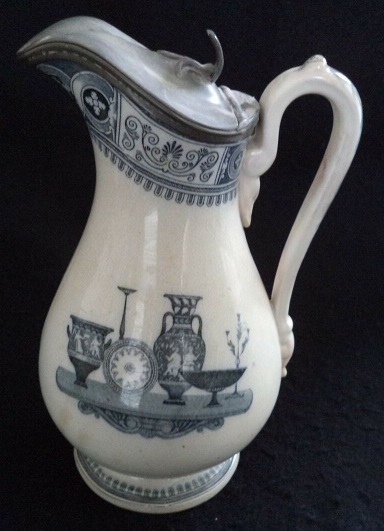Provenance: Great Britain, Staffordshire; Cobridge
Workshop: Elder Road Pottery Works in Cobridge; Thomas Furnival’s pottery shop
Faience; light fine clay, folding die casting, manual processing, drying, ceramic transfer printing, glazing, multiple firing; tin binding.
Dimensions: height 22 cm
Inw. pre-war HMM WPr. 1251
In 1927, an English faience jug, signed “FURNIVAL”, was purchased at an auction in Würz [burg]. Its purchase value is 25 marks (Fig. 1).
It was a tincture-jug with a balask-like body on a low base ring, which at the top passed into a wide, funnel-shaped spout with an equally wide, slightly raised and curved spout. A roller eye, made of a channel section, was attached to the place of the greatest extension of the abdomen and to the edge of the spout. The belly is decorated with a brown transfer printing technique, depicting four antique vases standing on the top of a furniture console (French pied de trumeau). There was an ornamental decoration in the form of a border or lambrequin under the spout. The outlet was framed by a thin tin cover. The word “FURNIVAL” was printed in brown on the bottom of the vessel.
Bibl .: Inventar Heimat Museum Marienwerder 1925-1944, p. 126, item 1251
Whether it was a faience vessel, or perhaps a glazed English stoneware, it is difficult to assess and verify today. Following Heym, we assume that it was a delicate earthenware vessel decorated with a transfer print decorated in a neoclassical style. In the years 1860–1870, the ceramic centers in Staffordshire returned to ancient designs. The most popular was the design called Etruscan Vases (Fig. 2), which was popularized by the Mayer & Elliot English manufacture in the 1870s until the 1880s.
In the years 1845-1870 Jakub Furnival (died 1880) ran a pottery on the Old Road in Cobridge and marked his products with his name. In the years 1851-1864, the brothers cooperated with each other. After his brother left the factory, Tomasz (died 1870) already ran two ceramic factories in Cobridge and Stoke-on-Trent. During this period, he still labeled products with his name only, rarely adding his monogram. The furnivals initially produced simple pottery, faience and stoneware toilet products for the American markets (United States, Canada), and several types of tableware and toilet services for the local market. Among the various products, the manufacture’s specialty was dinner and toilet services with an antique design on simple, white dishes that were cast in folding matrices. On plates and platters, decorations were often only cut edges with delicate, fine lines, which were filled with glaze. A characteristic feature of this manufacture was the combination of transfer printing, manual enamel painting and gilding on a burnt body (see: https://www.furnivals-pottery.weebly.com/thomas-furnival-1864-71.html (15/05/2019)) ..
(oprac. dr B. Pospieszna)


